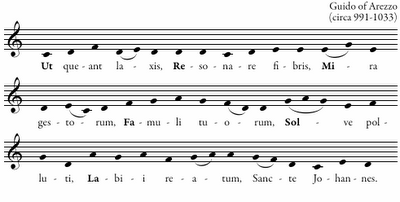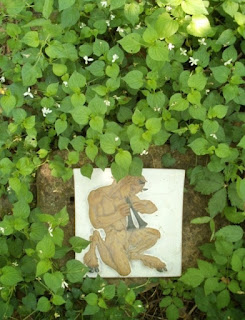 |
| Bees were called the birds of the Muses. Honey was mixed with milk or water or grains of wheat as offerings to the Muses. |
The Muses had several musical contests but only one was against another group of Muses. The two sets of Muses in this story were the 9 Olympian Muses and the 7 or 9 Muses of Pieria.
The Olympian Muses are the nine daughters of the Titan Mnemosyne, the Goddess of memory, names and language, and Zeus. They are the most widely known Muses today, but it took them quite some time to become the dominant version in Greek myth. The Romans assigned specific poetry, music and images to them but were not always consistent about it. They were all pictured with a lyre at one time or another.
1) Kalliope/Calliope, “of the beautiful voice,” is the Muse of epic or heroic songs. She leads the other Muses and plays the trumpet. She travels with leaders to inspire justice and thought. She settled the argument between Persephone and Aphrodite over Adonis.
Kalliope/Calliope is sometimes pictured with a scroll (book) and stylus (pen) or holding a laurel crown and the Homeric scrolls. In Renaissance times, she played the harp or lute.
2) Kleio/Cleo, “the giver of fame,” became the Muse of history poems. She spread the use of the alphabet and plays the trumpet. She is my pick for a Muse of brass instruments.
Kleio/Cleo is sometimes pictured with a chest of scrolls/books or a water clock.
3) Thaleia, “the festive or blooming,” can be found at the theater watching a comedy when she isn’t off with her other sisters, the Graces. She teaches geometry, architecture and agriculture. She invented the plectrum, used to strum the lyre.
Thaleia is sometimes pictured with a comedy mask, shepherd’s staff and ivy wreath. In Renaissance times, she played the rebec (early violin) or viol (stringed and bowed instrument that isn’t a violin).
4) Melpomene, “the singer,” prefers tragedies and elegies. She creates chants and plays the hunting horn.
Melpomene is sometimes pictured with a tragedy mask, sword, a wreath of ivy or cypress and wearing actors’ boots. In Renaissance times, she played the bass viol.
5) Euterpe, “the giver of joy,” is the Muse of instrumental music. She plays the aulos, a double-reed instrument. She loves wind instruments, lyric poetry and education.
Euterpe is sometimes pictured with the aulos or surrounded by many instruments. In Renaissance times, she played the flute or other woodwind instruments.
6) Terpsichore, who “enjoys dancing,” plays the lyre and dances. She loves large choruses in plays and education. She is occasionally the Muse of stringed instruments.
Terpsichore is sometimes pictured dancing, wearing a laurel wreath or holding a lyre. In Renaissance times, she played the cittern or large lute.
 7) Erato as the “awakener of desire” claimed erotic poetry, wedding music and dances that entice or require pairs. A prophetic priestess of Pan shares her name.
7) Erato as the “awakener of desire” claimed erotic poetry, wedding music and dances that entice or require pairs. A prophetic priestess of Pan shares her name.
Erato is sometimes pictured wearing a rose wreath or holding a lyre or jingle ring. In Renaissance times, she played the cittern.
8) Polyhymnia/Polymnia, “many hymns,” is best known for her sacred hymns and mimic arts. But through a link with Demeter, she is also the divine prostitute, the one who grants love to all. She makes the rules of grammar and teaches geometry and agriculture.
Polyhymnia/Polymnia was sometimes pictured wearing a veil or cloak. In Renaissance times, she played the organ or clavichord.
9) Ourania, the “heavenly one,” makes predictions by watching the stars and invented astronomy. Aphrodite took Ourania’s name as one of her titles: Aphrodite Ourania “the Heavenly Aphrodite,” the merciful one who dances to the music of the spheres.
Ourania is sometimes pictured with a compass and star globe. In Renaissance times, she kept time on a drum or gong.
At first, every village or kingdom had its own local Muses. Since Pieria is thought to be the place the more organized cult of the Muses began, the seven Muses of Pieria may have been a quite early group. (Confusingly, they are sometimes called the Muses of Lesbos, but Pieria is much more common.) Finding more information about them however, is not easy. Even the meanings of their names have to be pieced together from other myths. Their mother is a nymph named Antiope or Euippe. The name Euippe is closely related to Hera Hippia and Athena Hippia, the horse Goddesses. Their father Pierus is named for the land of Pieria itself. The seven Muses are named Rhodia, Asopo, Neilo, Achelois, Tritone, Heptapora and Tipoplo and their number matches the seven mitochondrial Eves, the genetic mothers of the human race.
 1) Rhodia is rose or rose garland or perhaps hibiscus or some other red to pink flower. Two sunny nymphs, Rhodos and Rhode, have very similar names. Some believed Rhodos was the same as Athena Hippia, and Rhode’s mother was sometimes the ocean nymph Polyphe, “of much thought.”
1) Rhodia is rose or rose garland or perhaps hibiscus or some other red to pink flower. Two sunny nymphs, Rhodos and Rhode, have very similar names. Some believed Rhodos was the same as Athena Hippia, and Rhode’s mother was sometimes the ocean nymph Polyphe, “of much thought.”
2) Asopo, “never silent,” is a river name. It may also mean “clever in all ways.”
3) Neilo may mean river and/or relate to the river Nile.
4) Achelois, “washes away pain,” is the name of a moon Goddess who was given offerings at the oracle of Dodona.
5) Tritone is three. Tritones are the sea creatures who look like the sea God Triton, the conch shell player. By coincidence, tritone is the name of the most famous interval in modern music theory, the augmented 4th or diminished 5th, the mid-point of the octave.
6) Heptapora is another river name, possibly one with seven springs, streams or paths.
7) Tipoplo, very tentatively, may be a bird call.
In later myths, Pierus is a mortal king who had nine daughters, instead of seven. He claimed his daughters sang as well as the more famous Muses, or he named them after the nine daughters of Mnemosyne and Zeus. Whether he did this out of pride or by order of an oracle depends on which story you read. Regardless, his daughters were worshiped as the true Muses of Pieria. Before long, they challenged, or were challenged by, the nine Olympian Muses to a singing contest, which was judged by the nymphs or nature itself. The music of the contest caused the Helicon mountain to rise up into the sky until, finally, Poseidon sent Pegasus to stomp on the mountain. Springs leapt up where the winged-horse’s hooves touched the ground and the Muses were worshiped at these springs. The singing daughters of Pierus, meanwhile, were declared the losers and changed into birds, either magpies or nine different birds: the grebe, the wryneck, the ortolan (or hawk/kestrel), the jay, the green finch, the gold finch, the duck, the woodpecker, and the dracontis pigeon.
About those birds…
The translations of the nine birds are a little uncertain. For the birders out there and for those who just like this kind of puzzle, here are the Greek bird names.
1) Colymbas/Kolymbus means shrub and may be the grebe.
2) Iynx is the wryneck and also means spell or charm.
4) Cissa/Kissa is the jay. Also a genus of magpies.
5) Chloris means green, may be the green finch and is used for many green birds. It is also the name of the flower Goddess who created the first rose.
6) Acalanthis/Akalanthis may be the gold finch, linnet or warbler.
7) Nessa means descending from above and may be the duck.
8) Pipo is the woodpecker.
Of course, anyone who enters a contest with the Gods is transformed. Some stories say it’s a reward; others that it’s a punishment. But there is no doubt that coming face to face with a God and showing exactly what you can do, exactly who you are, will change you deeply and leave you marked by having met Them. In this case, changing singers into birds, who spend their lives singing...well I leave you to decide precisely what that means.
For more on the other groups of Muses (yes, there are more), see Many Muses
Ovid's Metamorphoses
Hesiod's Theogony
Women of Classical Mythology by Robert E. Bell
The Marriage of Cadmus and Harmony by Roberto Calasso
The Gods of the Greeks by Kerenyi
Theoi.com
For more on the other groups of Muses (yes, there are more), see Many Muses
Ovid's Metamorphoses
Hesiod's Theogony
Women of Classical Mythology by Robert E. Bell
The Marriage of Cadmus and Harmony by Roberto Calasso
The Gods of the Greeks by Kerenyi
Theoi.com















